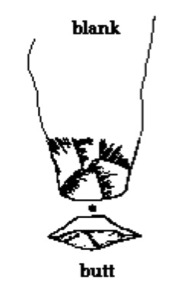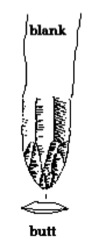A platform on a core can be prepared in a number of ways but the most common is by the removal of a number of small detachments, or platform preparation flakes, from across the surface of the platform. These differ from rejuvenation flakes or tablets in that here the purpose is to prepare the surface of a platform through the application of small controlled chips or flakes and not by the removal of the entire platform of a core. Regardless of the form applied, platforms are prepared to roughen the surface and increase the probability of a successful well-positioned and exact removal. Platform preparation is often encountered on more elaborate core types such as blade cores. (See Newcomer 1975, 97-102 and Owen 1988 3-7).
Platform preparation leaves distinct traces on the butt of an artifact. This preparation can take many forms but the most common result in a dihedral butt, faceted butt (or scarred butt), or a punctiform butt. (see Tixier 1980, 105, fig. 47: 3, 4 and 9).
dihedral butt
A dihedral butt is formed when the detachment blow is struck on the platform at the junction, or the ridge, between two removals.
prepared faceted butt
Faceted or scarred butts are formed by striking on a platform prepared by numerous removals. This type of preparation is particularly useful in roughening the surface and increasing the probability of a successful well-positioned and exact removal. This type of platform preparation is often encountered on more elaborate core types such as blade cores. (See Newcomer 1975,, 97-102 and Owen 1988, 3-7).
prepared punctiform butt
Punctiform butts result from the careful preparation of both the platform and front of a blade core. The use of indirect percussion is necessary to assure an exact blow is delivered to the tiny area left for striking after the preparation is complete
.

